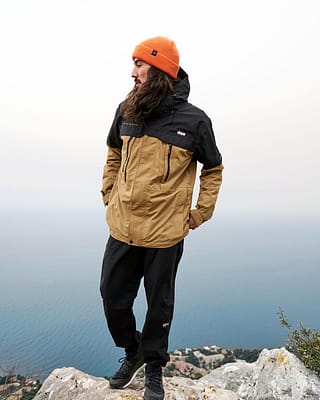What’s the difference between hiking and trekking
Hiking and trekking help us to raise our heart rate, see some stunning views along the route and push our limits in a controlled manner. Everything we are looking for in life.

Our generation has made a significant shift as if taking a 180-degree turn. Born into the technological age of smartphones and immediate information, we now find ourselves increasingly returning to nature and seeking outdoor experiences as a form of self-care. Some outdoor activities, such as hiking and trekking, have become more popular than others.
This raises a crucial question: What is the difference between hiking and trekking? You may have tried one or both of these activities but find the terminology confusing. So, what exactly are the differences? This article will break down the jargon and clarify the distinction between hiking and trekking. You'll discover the joy of connecting with nature while becoming a knowledgeable and sustainable traveller!

Some people use trekking and hiking as though they are synonyms, but in fact, they’re not. While they are all outdoor activities that get your blood pumping, exploring and enjoying nature, there are some differences between them. We hope after reading this article, you will have a clear understanding of the difference of hiking vs trekking, plus what you’d need when you participate in any of them and finally, list the pros and cons. So let’s dive in.
Essential Outfit Ideas for Hiking and Trekking
Are you planning your next hiking or trekking adventure and need some outfit inspiration? Look no further! Discover the latest looks, including our men's outdoor pants and women's outdoor pants. Make sure you gear up for your journey with these essential items.
What is hiking?
Hiking is by far the most leisurely activity of the three. Get started here and work up. Grab your boots, your fave podcast or a buddy! It involves walking on marked hiking trails of easy or moderate difficulty. Usually, hikes can last anywhere from half an hour to a half day or one day. Some of the most popular hiking spots in the World include the German Alps, which is as incredibly stunning in terms of the visuals as it is varied in the terrain. Instagrammable!
Is hiking difficult?
Although hiking is a more accessible activity, it can still prove to be a challenge to some people. Usually, hikes start and end in the same place. But some hikes have different starting and ending points. In most cases, a hike can last anywhere between 2 and 8 hours, but you can hike for as long as you please.

Clothing or equipment required
Before setting out on your hike, being equipped with the right clothing and gear is essential. Consult our hiking packing list to ensure you have everything you need. Key items include:
- Appropriate hiking footwear – if the hike is short, trail shoes will do. If the hike is long and you’ll carry a heavy load, then hiking boots are best
- Compass/GPS and a Map – these will help you find campsites and tell you where you are relative to your destination, emergency exit routes or water
- Water and a means of purifying it – water will not only keep you hydrated by also protect you from altitude sickness and hypothermia
- Extra food – the snacks you carry will help keep your energy levels high in case you get lost or when the terrain is more challenging than you thought or want to enjoy time by the river
- Rain gear and additional clothing – carry a hat and stay away from cotton clothing
- Safety items – you need things to make a fire, a whistle, and a flashlight. These are great if you will be hiking for long hours into the night
- First aid kit
- Knife
- Sunglasses and sunscreen
- Daypack or a backpack
- Trash bag to keep trash you come across on the trail
Fitness level required
Hiking is not so strenuous, but even then, you need to be prepared for it. Taking a walk twice or thrice during the week will do. During these walks, try and get your heart pumping for 30 minutes. Ensure that you wear the same shoes you will wear during the hike.
Advantages of hiking
- It helps reduce the risk of heart attack and heart disease
- Reduce blood pressure
- Reduce the risk of some cancers
- It burns calories and helps in weight loss
Disadvantages of hiking
- You might experience altitude sickness if you hike on mountains
- It can cause muscle soreness days after the trip
- Weather can change drastically while on a hike
What is trekking?
Trekking is right between sports like mountaineering and hiking with regards to difficulty. If you are a Swede, lets say this is the “Lagom” choice of activity, right down the middle, the goldie locks porrige that’s just right! However, it’s a little more similar to hiking. The difference between hiking and trekking is that treks tend to be longer than hikes as they can last a couple of days longer.
As such, you will have to camp or make plans to stay in mountain huts or small lodges along the trekking trail. Treks start and end in different places, and the distance can range from 40 to several hundred kilometres.

Clothing or equipment required for trekking
When packing for a trek, you should cap the backpack weight at 33 pounds. The checklist of things that you’ll need during the trekking trip includes everything you’ll need for a hike (mentioned above) plus several other items, including:
- A sleeping bag
- A camping mattress
- Toiletries
- Heavyweight gloves with waterproof coating
- A down jacket or vest
- Wool pants
- Trekking boots along with spare laces
- Warm hiking socks
- Gaiters
- Footwear to wear around the camp.
- Telescopic trekking poles (optional)
Fitness level required
Although you might feel ready for a trek, we encourage you to train ahead of time. The trekking training should start several months before the trek and focus on building your strength and working on your aerobic fitness.
Advantages of trekking
These advantages are in addition to what hiking has to offer.
- Enjoying the air freshness of the hills and mountain trekking trails
- Building your cardiovascular strength while on a trek
- Bonding and making new friends with hikers on the trails
- You enjoy stunning views (depending on the trekking trail)
Disadvantages of trekking
- You need a heavier pack
- More risky, primarily due to wild animals
- If you trek alone, you run the risk of having no support in the event of an injury
Top 3 hiking destinations in Europe
Italy, Lake Garda

Difficulty: Mixed
Optimum Season: All year
Ridestore Recommends: Hiking around Lago di Tenno
This location is an entire area as opposed to one particular trail for hiking. We simply couldn’t miss putting Lake Garda on the list for stunning hiking locations as it’s simply remarkable. Principally, areas around Riva Del Garda, Limone, Malcesine, Arco and above the north tip of the lake. There are more gorgeous lakes, mountains and an Austro- Italian vibe, which is really something. The landscape is varied with a hike to suit all abilities, head to the tourist office, pick up a hiking guide and be ready to have your eyes truly assaulted by the insane, breathtaking view.
Norway, Trolltunga

Difficulty: Intermediate
Optimum Season: Summer
Ridestore Recommends: Stay at the “Trolltunga Guesthouse for an authentic experience.
Trolltunga is an iconic sight in Norway. Most of you will be familiar with the landscape from the many-an-Instagram post, but the beauty really needs to be seen to be fully appreciated. There is a round trip, so to speak, a 28 km trail that starts at the Skjeggedal car park and ends in Trolltunga. The trail doesn’t have any amenities or facilities along the way, so be sure to pack accordingly.
Scotland, Skye Island

Difficulty: Beginner
Optimum Season: Spring or Summer
Ridestore Recommends: You have to see the Old Man of Storr rocks!
There are so many epic trails to explore on Skye Island, from the “Fairy Pools” that starts near Carbost to the astonishing Old Man of Storr. Skye is home to rugged landscapes, idyllic picturesque fishing villages and eerie medieval castles. The largest island in the Inner Hebrides archipelago, surrounded by a breathtaking coast line. If that doesn’t sell, Skye is your next hiking destination; I don’t know what will!
Top 3 trekking destinations in Europe
Germany, Baden-Baden (Black Forect)

Difficulty: Mixed
Optimum Season: Summer or Autumn
Ridestore Recommends: Wildgehege (wildlife reserve) – circular trail is the perfect mix of nature, wildlife and views.
A location pulled straight out of a fairy tale, lands that tell an enchanting story, the kind that cast your mind back to your childhood. Now, as adults, we can explore the black forest as the evocatively captivating place that it is. Many a trail to suit your level and desires, wildlife, spooky gothic architecture and lovely little cafes and restaurants to take rest after a long days trekking.
Slovenia, Triglav National Park

Difficulty: Mixed
Optimum Season: Summer
Ridestore Recommends: This is an awesome camping destination; why not turn a day trip into a longer adventure.
An area is filled with next-level lakes, rock pools and serene rivers, surrounded by imposing and rugged mountains. The weather is balmy yet fresh in the summer, meaning the conditions could not be better to camp. Take the pass less travelled and trekking between huts or find quiet little spots to pitch up after trekking for the day under the clear starry skies. Tranquillity itself!
Austria, Eagle Walk Lechtal Alps

Difficulty: Challenging
Optimum Season: Summer or Autumn
Ridestore Recommends: Book a nice hotel & spa in Lech am Arlberg after your trip to reward yourself and explore this pretty little village.
The famous Eagle Walk (Adlerweg in German) is a long-distance hut-to-hut trail that traverses the flabbergastingly beautiful Austrian State of Tirol. Here at Ridestore, we’re in love with Tirol (skiing in the winter and exploring in the Summer). Pack with camping or staying in huts in mind and enjoy the real back-to-nature atmosphere. The terrain can be challenging and trekkers should be prepared, but you will be awarded the best views and most lovely experience.
Wrapping up
So what do you think? Has this article helped you understand the differences between hiking and trekking?
Both hiking and trekking are super fun and great reasons to get outside, be in nature and connect with yourself again. You can now start studying your new route for a hike or a walk outdoors, or plan a multi day trekking tour with your friends.
What ever the reason you head outside, we hope you enjoy!
Related Reading:
- The Best Glamping Spots In Europe
- Men’s outdoor jackets / Women’s outdoor jackets
- Outdoor clothing for men / Outdoor clothing for women
- Wild Camping In Europe
- What Is Mountaineering
